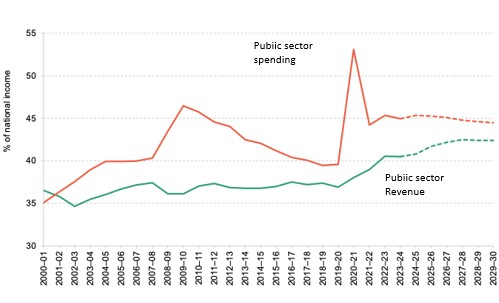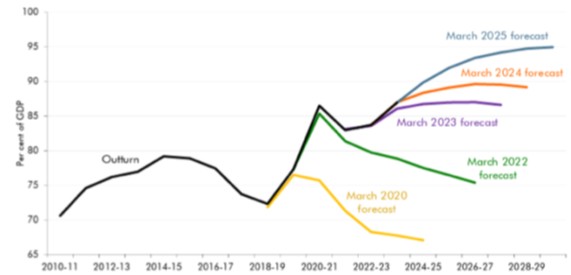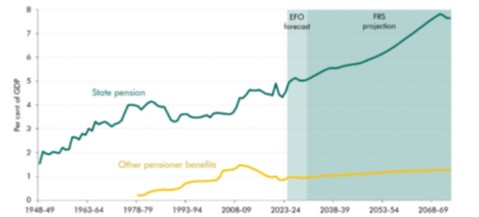The UK’s fiscal position is not just precarious; it is on the brink of becoming unsustainable. With just one more crisis, like the global financial crisis and the Pandemic that we’ve experienced in the last 20 years, the situation could escalate rapidly. A return to strong growth would reduce this risk but will be a long-term effort.
What does unsustainable look like? Well, it occurs when financial markets refuse to lend the government money by not buying its bonds, or at least at such high interest rates that it becomes impossible for the government to afford them. We know this is possible because that is precisely what led to the downfall of the Liz Truss government in 2022. The central issue is that the UK’s public sector debt has increased significantly since 2000 but cannot be reduced by either tax rises or spending cuts due to widespread voter resistance.
A glance at Chart 1 reveals the dramatic changes in UK public finances since the 2000s. The global financial crisis of 2008/9 led to a ratcheting up of public sector spending from under 35% of GDP to 45% of GDP.

It then gradually fell back to about 40% of GDP, but then the Pandemic struck, causing public spending to rise sharply once again to approximately 54% of GDP. Since then, it has dropped to about 45%, or by 14% of GDP. Forecasts extending five years show that it remains at around 45% of GDP, as shown in chart 1. At the same time, public sector revenues, which were around 35% of GDP, have risen to nearly 40% of GDP. That represents the highest tax take since World War II. However, that still means that, with spending remaining around 45% of GDP, the UK will continue to borrow 5% of GDP, as far as the eye can see. Moreover, as chart 2 below shows, forecasters tend to underestimate the rise in UK debt as a share of GDP, making higher deficits more likely.

Cutting public spending is not easy…
Efforts to reduce spending are not only unpopular but also met with significant resistance from the voting public. The new Labour administration, for instance, had to roll back on its attempts to reduce public spending on welfare and the winter fuel allowance due to this resistance.
It’s important to note the ‘triple lock’ system, which is the elephant in the room of UK politics. This system ensures that pensions rise in line with either the Consumer Price Index (CPI), 2.5%, or average earnings, whichever is higher. As a result, it pushes up pension costs as a share of GDP, as shown in the chart below. The issue is that no party is currently willing to tackle this, despite its significant impact on public finances. Therefore the ‘triple lock’ poses a big fiscal challenge as it leads to a continuous increase in pension costs, thereby reducing the government’s budgetary flexibility.
Public opinion polls consistently seem to convey a deceptively simple message: the public believes in controlling government spending and wants financial stability. However, any concrete proposals suggested to lower spending encounter opposition, and the government usually backs down.
…because public opinion has shifted
According to the British Social Attitudes Survey (BSAS) published in September 2023, most voters want the government to be involved in healthcare, the economy, and to support the standard of living. More specifically, over 60% believe the government should support industry. 89% supported the government taking and maintaining responsibility for providing healthcare for the sick, therefore supporting high NHS spending, and 81% supported maintaining a high standard of living for pensioners.
The reason for this shift in public attitudes is revealed in the BSAS, which also showed a significant change in views about the role of government. The majority now believe that it has a responsibility to pursue social and economic objectives. That change in contrast to the views held in the 1980s and 1990s, which supported reducing the government’s role in the economy.
With public expectations of government help at record highs, it’s no wonder that specific proposals are voted down and become politically unsustainable, rendering them a non-starter. And clearly, the key circumstances which have affected this change in public attitudes since the 1970s have been the Pandemic and the global financial crisis. However, this means that public finances are vulnerable to both foreseen and unforeseen circumstances.
Foreseen circumstances refer to those that data providers model and that the government uses in its spending plans and forecasts, such as demographic changes and economic cycles. Unforeseen circumstances, on the other hand, refer to unexpected events, such as natural disasters or geopolitical crises. Both types of circumstances pose significant fiscal risks, as they can lead to increased government spending and reduced tax revenues. As the Office for Budget Responsibility (OBR) pointed out in the 2025 risk assessment of the public finances, the UK is indeed in a very precarious position.
That matters because of increased public costs of servicing debt, and the consequent reduction in fiscal policy flexibility to meet changing economic circumstances as they arise. There are also arguments around needing ‘sound’ public finances to maintain investor confidence and so keep borrowing costs down. Doing so also means the government will have the flexibility in economic downturns to respond to crises by increasing borrowing, as seen during the Pandemic.

Meaning the debt burden will rise
The OBR also pointed out in its 2025 analysis of the UK’s long term fiscal outlook that some of the challenges for public spending are around demographic changes, including rising health care and pension costs, but also the effects of climate change and the added variability that it has to the shocks that occur and impact the economy, which requires the government to intervene and spend money.
Getting the public finances in good order is essential not only to meeting those challenges but also to run an efficient, modern economy that is future-proof for the foreseeable challenges built into its forecasts. Volatility and instability are in no one’s interests; therefore, maintaining sound public finances is not just important, but crucial to sustaining a stable and thriving economy, as well as low and stable interest rates that make housing affordable.

